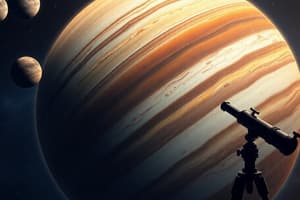Podcast
Questions and Answers
What is the primary composition of Jupiter's atmosphere?
What is the primary composition of Jupiter's atmosphere?
- Oxygen and nitrogen
- Nitrogen and helium
- Carbon dioxide and methane
- Hydrogen and helium (correct)
What gives Jupiter the largest ocean in the solar system?
What gives Jupiter the largest ocean in the solar system?
- Frozen water
- Ammonia clouds
- Liquid methane
- Compressed hydrogen gas (correct)
What causes the color bands visible on Jupiter?
What causes the color bands visible on Jupiter?
- Water and hydrogen sulfide
- Methane and ammonia
- Trace elements and convection (correct)
- Hydrogen and helium
What is the mass of Jupiter in terms of Earths?
What is the mass of Jupiter in terms of Earths?
What is the approximate density of Neptune?
What is the approximate density of Neptune?
How many hours does it take for Neptune to complete one rotation?
How many hours does it take for Neptune to complete one rotation?
Which element contributes to the color of Neptune?
Which element contributes to the color of Neptune?
What is the largest moon of Neptune?
What is the largest moon of Neptune?
Which moon in the solar system is the largest and has a magnetic field and signs of surface movement?
Which moon in the solar system is the largest and has a magnetic field and signs of surface movement?
Which moon in the solar system is known for its potential subsurface ocean and experiences tidal heating?
Which moon in the solar system is known for its potential subsurface ocean and experiences tidal heating?
Which moon in the solar system is the most volcanically active body with sulfur-colored lava flows?
Which moon in the solar system is the most volcanically active body with sulfur-colored lava flows?
Which moon in the solar system has the largest ring crater, Valhalla Basin, and is composed of solid rock-ice?
Which moon in the solar system has the largest ring crater, Valhalla Basin, and is composed of solid rock-ice?
Which planet in the solar system is the ringed planet with the lowest average density and primarily hydrogen atmosphere?
Which planet in the solar system is the ringed planet with the lowest average density and primarily hydrogen atmosphere?
Which moon of Saturn was discovered to have water-ice jets by the Cassini mission?
Which moon of Saturn was discovered to have water-ice jets by the Cassini mission?
Which planet in the solar system has an axis of rotation tilted 98 degrees?
Which planet in the solar system has an axis of rotation tilted 98 degrees?
Which planet in the solar system was found to have evidence of an ocean of boiling water and new moons by Voyager 2?
Which planet in the solar system was found to have evidence of an ocean of boiling water and new moons by Voyager 2?
Which planet in the solar system is very similar in size and composition to Uranus?
Which planet in the solar system is very similar in size and composition to Uranus?
Which planet in the solar system has the largest moons composed of ice and rock?
Which planet in the solar system has the largest moons composed of ice and rock?
Flashcards are hidden until you start studying
Study Notes
The Moons of Jupiter, Saturn, Uranus, and Neptune
- The Great Red Spot is a giant storm on Jupiter, larger than Earth, but recently shrinking
- Jupiter's largest moons are spherical and have interesting features, such as potential subsurface oceans on Ganymede and Europa
- Ganymede is the largest moon in the solar system and has a magnetic field and signs of surface movement
- Europa may have a vast subsurface ocean and experiences tidal heating
- Io is the most volcanically active body in the solar system, with sulfur-colored lava flows
- Callisto has the largest ring crater, Valhalla Basin, and is composed of solid rock-ice
- Saturn is the ringed planet with the lowest average density and primarily hydrogen atmosphere
- Saturn's rings are a system of orbiting particles of ice, dust, and small moons
- The Cassini mission discovered water-ice jets on Enceladus and hydrocarbon lakes on Titan
- Uranus has an axis of rotation tilted 98 degrees, and Voyager 2 found evidence of an ocean of boiling water and new moons
- Uranus has five large moons composed of ice and rock
- Neptune is very similar in size and composition to Uranus, with a diameter about 4 times that of Earth
Studying That Suits You
Use AI to generate personalized quizzes and flashcards to suit your learning preferences.




